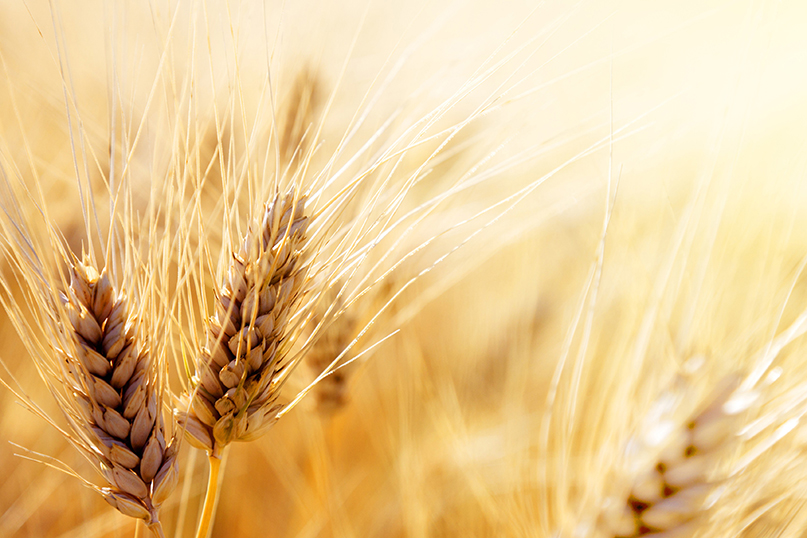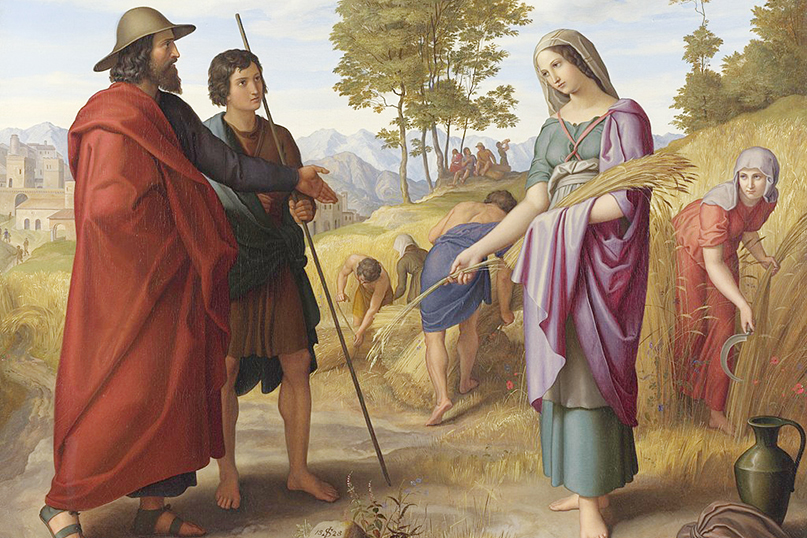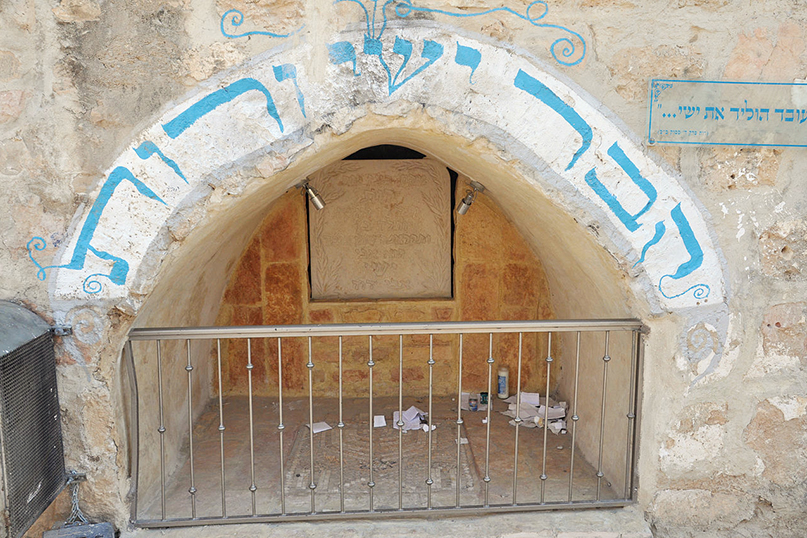
By Deborah Fineblum
“You shall love the convert for you were strangers in the land of Egypt.”
– Deuteronomy 10:19
(JNS) There was a moment some 2,500 years ago when a recently widowed Moabite princess refused to abandon her aging mother-in-law and return home – a moment that made history by becoming the first convert in recorded Jewish history.
Ruth’s words – “Where you go I will go, and where you stay I will stay. Your people will be my people and your God my God. Where you die I will die, and there I will be buried” – have echoed down through the generations, as powerful now as the day they were spoken.
The biblical woman is recalled each spring as Jews everywhere read the story of devotion and love during the holiday of Shavuot (beginning at sunset on Thursday, May 28, it lasts two days in the Diaspora and one in Israel). It’s a time when Jews the world over remember that awesome morning 3,332 years ago when God revealed Himself to a ragtag bunch of escaped slaves at Mount Sinai and gave them a lasting gift: the Torah. It’s an event now marked by late-night Torah study, confirmations and dairy foods such as blintzes and cheesecake.

Credit: Wikimedia Commons.
But honoring Ruth doesn’t just have to be limited to Shavuot. There are echoes of her legacy every time a woman steps out of her conversion mikvah, having promised to make the Jewish faith her own. For Ruth–and for them–this means adopting not just a Jewish identity but a Jewish destiny, pledging that their descendants will keep the faith. In her case, Ruth’s great-grandson would be no less than King David, and his son, Solomon, inheriting the throne of Israel after him.
“Hers is a story of great love,” says Rabbi Moshe Miller, author of Rising Moon: Unraveling the Book of Ruth. “She leaves her homeland after suffering terrible personal losses and is reduced to grinding poverty in a foreign land, only to discover love and become the mother of the royal house of her adopted country.”
Miller says since “Ruth embraced a new identity and a new future,” then her spiritual “daughters” are certainly following her lead.
‘This is their place’
At a time of continued intermarriage (the 2013 Pew report revealed that 44 percent of American Jews’ marriages are to non-Jews, with the percentage increasing to 58 percent when counting those wed after 2005), of the roughly 17 percent who become Jews through conversion, most are female. At least if the students at the Route 613 conversion preparation program are any indication, women represent some 80 percent of the Manhattan-based conversion program.
Director Rabbi Maury Kelman says the prospective converts he has taught in the last 16 years include spiritual searchers chafing under birth religions that don’t fit, those with Jewish fathers, others whose Jewish friends took them to Shabbat and other celebrations, and those in a romantic relationship with someone Jewish. “Many tell me they always felt an affinity with Judaism, and then maybe in college they took a course in world religions and BOOM! It hits them that this is their place.”
And although Kelman says it’s hard to generalize, he’s convinced that “women tend to have a more spiritually seeking side than men,” and they’re often drawn to Judaism’s positive focus on marriage and the family, especially reflected in the observance of Shabbat when families, freed from technological distractions, “focus on each other for 25 hours – eating, praying and playing together.”

(Credit: Wikimedia Commons)
Also, while most of his students are not dating a Jew and are interested in converting for various other reasons, says Kelman, “in the situations where a couple does approach me, it’s usually a Jewish man dating a non-Jewish woman.”
More women joining the Jewish people makes sense when it comes to affecting the next generation. So says Rabbi Manis Friedman, longtime Chabad-Lubavitch emissary in Minnesota, author of Doesn’t Anyone Blush Anymore? (1990) and dean of the Bais Chana Institute of Jewish Studies, where he’s worked with countless women converts.
“The mother’s influence is simply stronger than the father’s,” says Friedman. “And we’re not talking about chromosomes here; we’re talking about a mother’s greater influence on her child’s developing soul.”
One huge bonus: Many on the path to conversion pull their Jewish partners in with them, which is why they’re asked to attend Route 613 class and gatherings. “With the student often really getting really into it,” says Kelman, “this is a journey they really need to take together.”
That’s what happened with Allison and Paul Holzer, who met back in 2002. When they began to get serious, Allison, a Kentucky native, says, “I knew it was part of his identity, so at first, I just I wanted to understand what Judaism was all about.”
Indeed, Holzer says she in no way expected to be “so intrigued and so engaged.” And, taking an Introduction to Judaism class a couple times, her enthusiasm both grew and became contagious. “Paul didn’t grow up religious, but he started engaging more as I was engaging.”
Moving to West Hartford, Conn., in 2012, she relates that “we discovered Passover and really embraced it.” They married and had their first son (they’ve since had their second), and Holzer joined a mother’s circle at the local Jewish Community Center. “Eventually,” she says, “it was becoming clear to me how much Judaism was aligned with my own values.”
But though she says she “felt Jewish long before I went into the mikvah,” the ritual itself – which she did as part of a ceremony with her sons and husband – turned out to be a watershed event. “I had thought I was already there, but afterwards, I felt a much greater sense of the commitment that we were collectively owning as a family.”

As their older son, Adrian, now 9, told them: “Before that we were half-Jewish, and now we’re all Jewish.”
But Holzer herself sees it a little differently. “I feel I’m not really a different person now that I’m Jewish. Maybe I’m just more me.”
‘Part of a people, tradition and history’
It took Gayle Berman 17 years after her first date with the Air Force Band’s principle clarinetist Harold Berman in 1989 to take the plunge. But, she will tell you, the process began years before. Growing up on a farm in Illinois, Gayle Redlingshafer was working as choir director for a Texas megachurch when she met the clarinetist in question. But it wasn’t until after they married and moved to Boston for law school (his) and a doctorate of musical arts program (hers), and after they adopted baby Micah from the former Soviet Union that Berman began thinking of herself as raising her child as a Jew.
In fact, it began the day she picked up Micah from preschool, and he was saying, “I am the Pharaoh, and I will not let your people go.”
“Seeing him so comfortable in this world, I felt something blossoming inside me,” she recalls 18 years later. Much of this transformation is recorded in the Bermans’ memoir Doublelife: One Family, Two Faiths and a Journey of Hope.
Between Micah’s arrival and that of their daughter Ilana, Berman took conversion lessons in Boston and, later, in Springfield, Mass., where she met with the beit din. The entire family immersed in the mikvah one autumn morning in 2006. “Harold had always said, ‘If you convert, I want you to do it only when it’s the right thing for you and not for me or my family,’ but by then, it was definitely my soul talking.”
On that same day, the Bermans were married again – this time in a religious ceremony with their children under the chuppah with them.
Moving to Israel was another step that appeared initially “impossible,” she says. Back in Springfield, having returned from a family trip to Israel, they noticed 4-year-old Micah counting his leftover shekels. When asked why, he casually announced his intention of living in Israel, and that he was saving them for that time. Four years later, they were on a flight back to Israel, this time as incoming new citizens.
What does the potential convert actually see in Jewish tradition, belief and history?
In Ruth’s case, says Miller, it was her mother-in-law.
“Naomi was a person of extraordinary character. Ruth observed her and saw the light of goodness radiating from her, and she knew she wanted to be part of that light.” It was a yearning so powerful, he adds, “that she had no hesitation to leave everything she knew and become part of a tradition, a people, and eventually even its history.”
‘Just as Jewish as any of us’
Even when the original premise disappears, this new belonging often stays strong and unshakable.
That’s what Irini Lulu learned. Born in Greece into the Greek Orthodox faith, in 2009 she found herself living between New York City and Philadelphia, involved in a serious relationship with a Jewish man and learning about Judaism in the Route 613 program. By 2011, that relationship became history, but her love affair with Judaism was in full swing, and she emerged from the mikvah as a Jew the following year.
“Everything I heard in class, everything I read, made total sense to me, all of it,” she says. “After a while, I realized I didn’t have to be in love with the person anymore, but I could be completely in love with the Jewish religion. As a way of life, it just made sense to me.”
Looking back on it, she says, “I think he was the messenger that brought me to it. And if anything comes too easily, you don’t appreciate it.”
In 2013, she met Omri Lulu, the man she would marry (with Kelman conducting the wedding). They’ve now had three children together and live in Philadelphia. “I look at my conversion like it was my Ph.D.,” says Lulu. “I’ve learned you have to see the good in every difficult circumstance, that all the hard times happen for a reason – the Jews I’ve met and now being a Jew myself that taught me that.”
Indeed, the Jews they meet have a profound impact on a convert or prospective convert–a lesson Miller reminds us that we can learn from how Naomi took Ruth under her wing.
Indeed, with much emphasis and numerous programs designed to help people prepare for this life translation, there is a risk of neglecting the after-support, agrees Kelman. “They need to be able to turn to us throughout the entire adjustment period, including being sensitive to feelings of their family.”
For Holzer, this support was crucial. “My friends, my rabbis and teachers, the whole community have been there for me throughout,” she says. “Never pushing, but always available when I need to talk.”
It helps to remember that in a spiritual sense, the Jewish world is simply welcoming these folks home, says Friedman. “When we consider that their souls were already Jewish – and converts will say, ‘I don’t know why, I just had to be Jewish’ – once they convert, they’re just as Jewish as any of us. It’s just that we had the womb to be born from and they had the mikvah water.”
‘From the first Shabbat, I fell in love with it’
Though Ruth neglected to say that, she certainly could have, since after the former Moabite princess’s child’s child’s child (David) ascended the throne of Israel, as did his child (Solomon), Miller says it earned her the title as “mother of royalty.”
The children of Ariella Aili Craven are also being raised a world away from their mother’s birthplace (Singapore) and far from the other places she’s called home over the years, including Hong Kong, London and New York.
In fact, Shabbat mornings now typically find her 5-year-old son and 2-year-old daughter in children’s services at their Jerusalem synagogue – services their mother happens to be leading.
Hers was a Jewish journey that began nearly two decades ago back in Singapore when she met a Jewish fellow named Joseph Craven. “He wasn’t religious at all, but after I graduated, I wanted to go to Israel to see what Judaism was all about,” she says. “From the first Shabbat, I fell in love with it; all the questions Christianity couldn’t answer for me, Judaism did. I started wondering why everyone wasn’t converting to Judaism.”
Craven’s conversion spanned many years and many countries but, in the end, she knew that Israel needed to be their home. “I wanted to make sure my kids have Yiddishkeit,” she says. “Raising them here, I know their foundation is strong, to be able to withstand the pressures of the outside world when they get older, whatever they will be.”
And like Ruth, their spiritual mother, Craven, Berman, Lulu and Holzer are among those who are able to see their commitment to the Jewish people pass down to the next generation.
It’s a future even more long-term for Sarah Katherine Schiffer of Freeport, Maine, a descendent of Mayflower stock who was recently able to witness her granddaughter’s moment under the chuppah. “Such nachas,” says Schiffer with a sigh.
At 14, she got her hands on a copy of Herman Wouk’s This is My God, which launched a serious study of Judaism. That same year, when her grandmother died and was laid out in an open coffin, the teen was “appalled” and instructed her family that, should she meet an untimely end, “to bury me in a way as close to the Jewish tradition as possible.”
By 18, she moved out of the house so she could set up a kosher kitchen; by 19, she was pummeling the rabbi who steadfastly refused to convert her with letter after insistent letter. “I wouldn’t take ‘no’ for an answer, and I got more and more aggressive,” she says. The following year, the rabbi relented and she converted.
“I am glad I was able to become Jewish and raise Jewish kids,” says Schiffer, now 69, “and even see my daughter marry a rabbi. “But to have Jewish grandchildren? That’s the icing on the cake.”







 Southern New England Jewish Ledger
Southern New England Jewish Ledger











